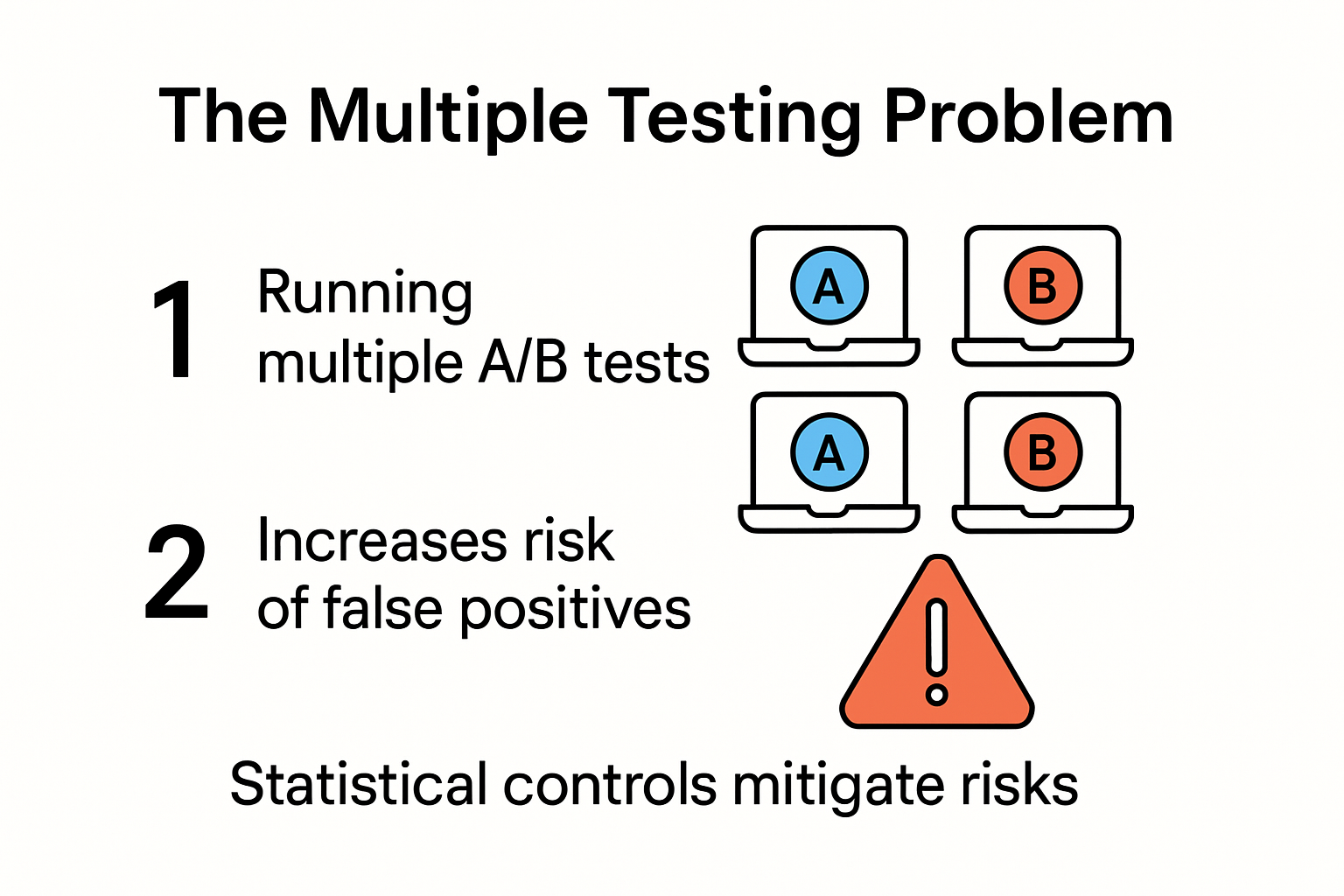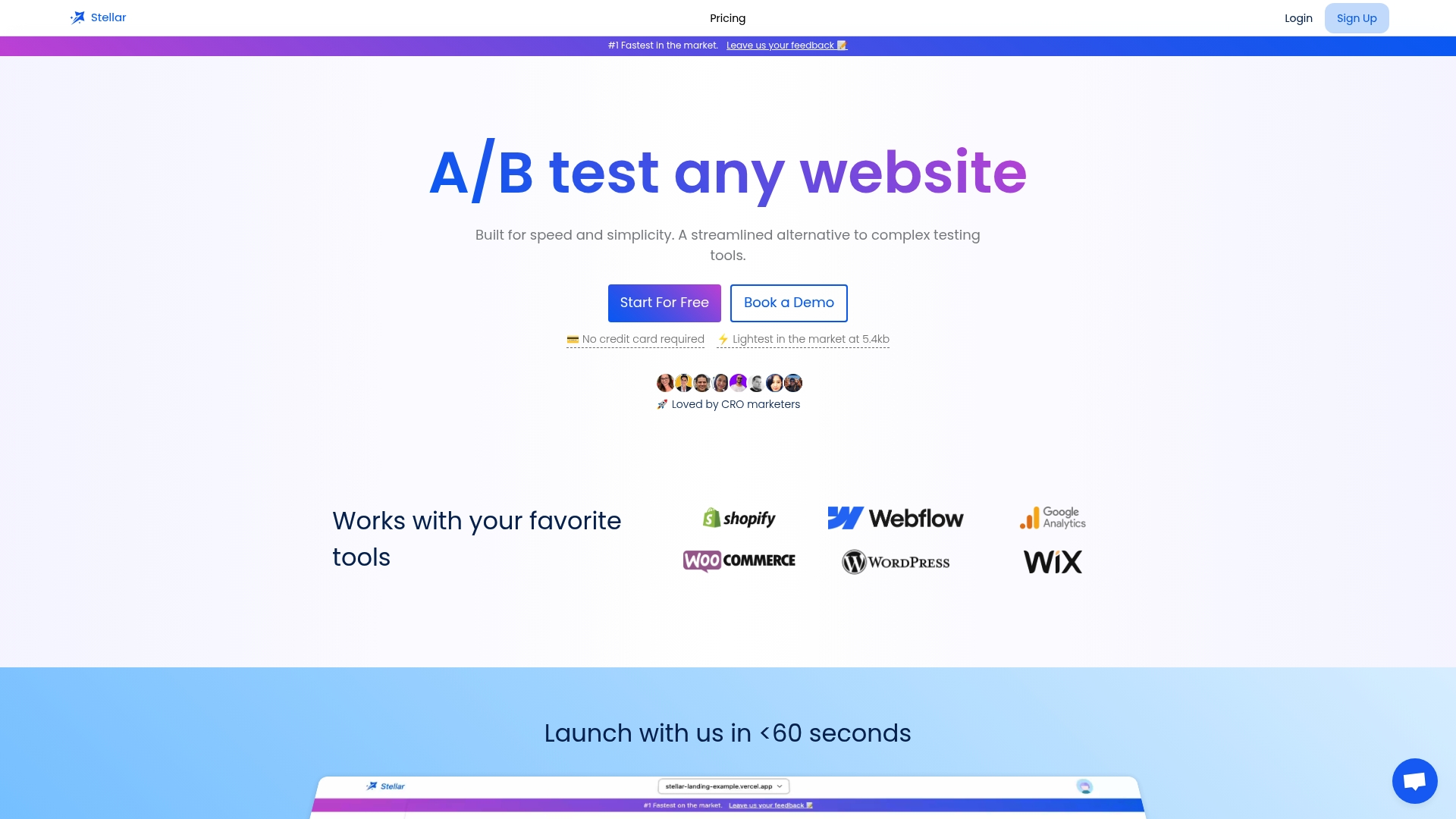
AB Testing Challenges Marketers Face: Common Pitfalls in 2025

Marketers are running more A/B tests than ever, chasing fine-tuned growth with every experiment. Yet, get this. Just one misstep in how you collect or interpret data can render an entire experiment useless, with studies showing that even top brands fall victim to 'sample ratio mismatch' and false positives upwards of 20 percent of the time. Turns out, the trickiest AB testing pitfalls in 2025 are not technical errors but psychological traps and organizational habits most teams overlook.
Table of Contents
- Identifying Misleading AB Testing Results
- Sample Size And Test Duration Mistakes
- Dealing With Technical And Data Issues
- Overcoming Organizational And Resource Barriers
Quick Summary
| Takeaway | Explanation |
|---|---|
| Avoid Statistical Illusions | Be cautious of heavy-user bias and confirmation bias when interpreting A/B test results, as these can lead to misleading conclusions. Use blind analysis and involve diverse team perspectives to strengthen objectivity. |
| Ensure Adequate Sample Size and Test Duration | Utilize sufficient sample sizes and appropriate test durations (ideally 1-4 weeks) to enhance statistical power and reliability. Small samples can produce spurious results and premature tests may overlook genuine behavioral patterns. |
| Address Technical Challenges | Mitigate issues like Sample Ratio Mismatch (SRM) and telemetry data loss by implementing robust tracking systems and cross-platform validation techniques to ensure data integrity in experiments. |
| Promote Cultural Alignment and Resource Optimization | Foster a culture that embraces data-driven experimentation, allocate dedicated budgets, and invest in training to enhance data literacy across teams for effective A/B testing implementation. |
| Tackle Technological Barriers | Enhance technological readiness by focusing on robust data infrastructure, integration capabilities, and scalable frameworks to support increasingly complex experimental designs. |
Identifying Misleading AB Testing Results
A/B testing promises data-driven insights, but marketers often fall into traps that can completely derail their optimization efforts. Understanding how to identify and prevent misleading test results becomes crucial in maintaining the integrity of your experimental process.
The Danger of Statistical Illusions
Marketers frequently misinterpret test data due to common statistical misconceptions. Learn more about data-driven insights to avoid these pitfalls. Heavy-user bias represents one of the most significant challenges in A/B testing accuracy. According to research from Cornell University, frequent users can disproportionately influence experimental outcomes, creating a skewed representation of actual user behavior.

This bias occurs when your most engaged users interact differently from your broader audience. For instance, power users might click through multiple pages, interact more frequently, or have different navigation patterns compared to casual visitors. Such behavior can create a false positive result that doesn't reflect the true user experience.
Preventing False Positive Traps
The multiple testing problem dramatically increases the risk of drawing incorrect conclusions. As researchers from Stanford University highlight, conducting numerous simultaneous A/B tests exponentially raises the likelihood of encountering statistically spurious results. These false positives can lead marketers to implement changes that actually harm conversion rates.

To mitigate these risks, implement rigorous statistical controls. This includes:
- Appropriate sample sizes: Ensure your test includes enough participants to generate statistically significant results
- Controlled significance levels: Use methods like Bonferroni correction to adjust for multiple comparisons
- Consistent monitoring: Track test results continuously to identify potential anomalies
Psychological Traps in Data Interpretation
Confirmation bias represents another critical challenge in A/B testing. Research from experimental psychology demonstrates how marketers unconsciously interpret data to support their preexisting beliefs. This psychological trap can lead to selective data interpretation, where positive results are overemphasized while contradictory evidence is dismissed.
Combating confirmation bias requires a disciplined approach. Establish clear hypotheses before running tests, use blind analysis techniques, and create a structured review process that encourages objective evaluation. Involve team members who can provide alternative perspectives and challenge initial interpretations.
Successful A/B testing demands more than just running experiments. It requires a sophisticated understanding of statistical methods, user behavior, and psychological biases that can distort data interpretation. By recognizing these potential pitfalls, marketers can develop more robust testing strategies that deliver genuine, actionable insights.
Sample Size and Test Duration Mistakes
A/B testing success hinges on precise experimental design, with sample size and test duration playing critical roles in generating reliable insights. Marketers frequently underestimate the complexity of these fundamental parameters, leading to statistically insignificant or misleading results.
The Critical Role of Sample Size
Discover advanced testing strategies to enhance your experimental accuracy. Insufficient sample sizes represent a fundamental challenge in A/B testing methodology. Research from the National Institutes of Health demonstrates that small sample sizes dramatically increase the probability of drawing incorrect conclusions.
When sample sizes are too small, statistical noise can easily overwhelm genuine user behavior patterns. This means minor fluctuations or random variations can appear significant, leading marketers to make misguided optimization decisions. Statistical power becomes critically important. A robust sample size ensures that detected differences between variations are genuine and not mere coincidences.
Calculating the appropriate sample size involves multiple considerations:
- Expected conversion rate: Understanding baseline performance
- Minimum detectable effect: Identifying meaningful performance differences
- Statistical significance level: Determining confidence thresholds
- Statistical power: Ensuring reliable result detection
Test Duration Dynamics
Test duration represents another crucial factor often misunderstood by marketers. Clinical research methodologies highlight that prematurely terminating A/B tests can produce unreliable outcomes. Running tests for insufficient duration introduces significant variability and reduces the reliability of experimental results.
Multiple temporal factors influence test reliability:
- Weekly traffic patterns: User behavior varies across different days
- Seasonal variations: Holiday periods or special events impact user interactions
- User diversity: Ensuring representation across various user segments
Ideal test duration typically ranges between one to four weeks, depending on website traffic and conversion rates. Shorter tests risk capturing momentary fluctuations, while excessively long tests might introduce external variables that compromise result integrity.
Statistical Significance and Confidence Intervals
Understanding statistical significance goes beyond simple numerical thresholds. Academic research in experimental design emphasizes the importance of confidence intervals in interpreting A/B test results.
Confidence intervals provide a range of probable outcomes, offering more nuanced insights than binary significant/insignificant classifications. A 95% confidence interval means there is a 95% probability that the true population parameter falls within the specified range. This approach allows marketers to make more informed decisions by understanding potential variation.
Key strategies for robust A/B testing include:
- Predetermining sample size requirements
- Establishing clear statistical significance thresholds
- Implementing comprehensive monitoring protocols
- Avoiding premature test termination
Successful A/B testing demands meticulous attention to experimental design. By understanding sample size complexities, respecting appropriate test durations, and interpreting results through sophisticated statistical lenses, marketers can transform experimental data into genuine optimization opportunities.
To help clarify the relationship between sample size, test duration, and resulting data quality, here is a summary table of common mistakes and their consequences:
| Mistake | Description | Common Consequence |
|---|---|---|
| Insufficient Sample Size | Too few participants in experiment | Increased false positives/negatives |
| Excessive Sample Size | Unnecessarily long or costly tests | Wasted time and resources |
| Premature Test Termination | Ending test before enough data is gathered | Unreliable, inconclusive results |
| Overly Long Test Duration | Running tests beyond necessary timeframe | External variables may skew results |
| Ignoring User Diversity | Failing to represent different user segments | Biased results; lack of generalizability |
| Overlooking Weekly/Seasonal Patterns | Not accounting for typical behavioral fluctuations | Misleading outcome trends |
Dealing With Technical and Data Issues
A/B testing in the digital marketing landscape is fraught with technical complexities that can undermine the most carefully designed experiments. Understanding and mitigating these technical challenges becomes paramount for generating reliable, actionable insights.
Sample Ratio Mismatch and Data Integrity
Explore advanced testing techniques to prevent experimental errors. Sample Ratio Mismatch (SRM) represents a critical technical challenge that can completely invalidate A/B test results. According to Microsoft Research, SRM occurs when the actual traffic allocation between control and treatment groups deviates significantly from the intended configuration.
The implications of SRM are profound. When user assignment to test groups becomes unbalanced, it introduces selection bias that can lead to entirely misleading conclusions. Potential causes include:
- Incomplete tracking: Failures in logging user assignment
- Technical infrastructure issues: Uneven data collection across test variants
- Platform limitations: Inconsistent user tracking mechanisms
The following table summarizes key technical/data issues in A/B testing and effective mitigation strategies discussed in the article:
| Issue | Impact on Testing | Mitigation Strategies |
|---|---|---|
| Sample Ratio Mismatch (SRM) | Selection bias; invalid results | Monitor allocations, improve assignment tracking |
| Telemetry Data Loss | Reduced statistical power | Redundant logging, error recovery, real-time data validation |
| Platform Delivery Divergence | Skewed comparison, segmentation | Standardize targeting, cross-platform validation, metadata docs |
Telemetry and Data Loss Challenges
Telemetry data loss emerges as another critical concern in A/B testing methodologies. Research from computational statistics highlights how data upload interruptions or processing errors can dramatically reduce experimental statistical power.
Effective strategies to mitigate telemetry challenges include:
- Implementing redundant data collection mechanisms
- Creating robust error recovery protocols
- Developing comprehensive logging systems
- Establishing real-time data validation checks
Platform-Specific Experimental Limitations
Divergent delivery represents a sophisticated challenge in digital experimentation. Marketing research from the American Marketing Association reveals how different ad platforms can inadvertently skew test results by targeting varying user segments.
This phenomenon occurs when platform algorithms automatically segment and target users differently across test variations. The result: performance differences that stem from audience composition rather than actual content variations. To combat this, marketers must:
- Carefully document platform-specific targeting behaviors
- Use consistent audience targeting parameters
- Implement cross-platform validation techniques
- Maintain detailed experimental metadata
Technical A/B testing challenges demand a proactive, multifaceted approach. By understanding potential data integrity issues, implementing robust monitoring systems, and maintaining a critical perspective on experimental design, marketers can transform potential technical obstacles into opportunities for more precise, reliable insights.
Successful experimentation requires more than just running tests. It demands technical vigilance, sophisticated data management, and a deep understanding of the complex digital ecosystems where these experiments unfold.
Overcoming Organizational and Resource Barriers
A/B testing represents more than a technical challenge. It demands comprehensive organizational transformation, requiring strategic alignment, cultural adaptation, and resource optimization to drive meaningful experimental practices across marketing teams.
Cultural and Strategic Alignment
Explore strategic experimentation frameworks to align organizational objectives. Systematic research from organizational development reveals multiple complex barriers preventing effective A/B testing implementation, including cultural, technical, and strategic challenges.
Organizational resistance typically manifests through several key dimensions:
- Decision-making inertia: Traditional hierarchies that discourage data-driven experimentation
- Risk-averse leadership: Reluctance to challenge existing performance models
- Siloed departmental structures: Limited cross-functional collaboration
Resource Allocation and Knowledge Management
Institutional support represents a critical factor in successful A/B testing adoption. Research in educational transformation emphasizes that clear implementation strategies are fundamental to overcoming organizational barriers.
Effective resource allocation requires:
- Dedicated experimentation budgets
- Training programs for data literacy
- Establishing cross-functional experimental teams
- Creating transparent performance evaluation metrics
Technological and Infrastructural Challenges
Organizational learning research highlights that technological limitations and unclear knowledge implementation strategies significantly impede experimental practices. Technological readiness becomes a crucial predictor of A/B testing success.
Key technological considerations include:
- Data infrastructure: Robust analytics platforms
- Integration capabilities: Seamless connection between testing tools
- Security and compliance: Protecting user data during experiments
- Scalable experimental frameworks: Supporting growing testing complexity
Below is a summary table outlining common organizational barriers and ways to overcome them based on the article's recommendations:
| Barrier | Example from Article | Recommended Solution |
|---|---|---|
| Decision-making inertia | Hierarchies resisting experimentation | Empower cross-functional teams |
| Risk-averse leadership | Leadership not challenging status quo | Foster experimentation-positive culture |
| Siloed departmental structure | Lack of collaboration between teams | Facilitate knowledge sharing |
| Lack of resources/training | No dedicated experimentation budget | Allocate funds, provide staff training |
| Technological limitations | Insufficient integration/data platform | Invest in scalable infrastructure |
Successful organizational A/B testing transformation requires a holistic approach. Leaders must simultaneously address cultural resistance, allocate appropriate resources, invest in technological capabilities, and create a supportive ecosystem that values continuous experimentation. By recognizing and systematically dismantling organizational barriers, companies can unlock the full potential of data-driven optimization strategies.
The journey toward becoming an experimentation-driven organization is complex. It demands persistent leadership, strategic investment, and a commitment to cultivating a culture that views every interaction as an opportunity for learning and improvement.
Frequently Asked Questions
What are the common pitfalls of A/B testing?
Common pitfalls of A/B testing include sample ratio mismatch, misinterpretation of data due to psychological biases, insufficient sample sizes, and premature test termination. These issues can lead to misleading results and ineffective optimization strategies.
How does sample size affect A/B testing results?
Sample size significantly affects the reliability of A/B testing results. Insufficient sample sizes can lead to increased false positives and misleading conclusions, while adequate sample sizes ensure that detected differences between variations are statistically significant.
What is the importance of test duration in A/B testing?
Test duration is crucial in A/B testing as it allows for the collection of sufficient data over time, capturing different user behaviors. Tests should ideally run for 1 to 4 weeks to avoid misleading results from random fluctuations or seasonal influences.
How can I prevent false positives in A/B testing?
To prevent false positives, implement rigorous statistical controls, including using appropriate sample sizes, adjusting significance levels for multiple comparisons, and continuously monitoring test results for anomalies.
Turn AB Testing Challenges Into Wins With Stellar
Are you tired of running A/B tests only to face misleading results, sample ratio mismatches, or unpredictable technical hiccups? The pitfalls outlined in this article—like false positives, incomplete data, or biased outcomes—can lead to costly mistakes and wasted time. Marketers at small and medium-sized businesses deserve an easier, more reliable way to experiment and grow, without the complexity of old-school tools.

Ready for a better approach? Experience uniquely simple A/B testing with Stellar. Our platform puts powerful, no-code testing in your hands, using a lightweight 5.4KB script to protect site speed and user experience. Achieve fast, trustworthy experimentation with real-time analytics and advanced goal tracking. Discover how you can run tests effortlessly and avoid common AB testing pitfalls—visit Stellar's homepage now and see how easy it can be to get actionable insights without technical hassle.
Recommended
- Conversion Rate Optimization Strategies for Marketers in 2025
- Testing to Optimize Conversions: CRO Strategies for 2025
- Signification des Tests A/B : Découvrir des Insights Basés sur les Données pour de Meilleures Conversions
- Qu'est-ce que le test AB en marketing digital : Le guide ultime pour améliorer les résultats des campagnes
- SEO AB Test Strategies for CRO Marketers in 2025
- Significado de A B Testing: Descubre Insights Basados en Datos para Mejores Conversiones
Published: 7/2/2025